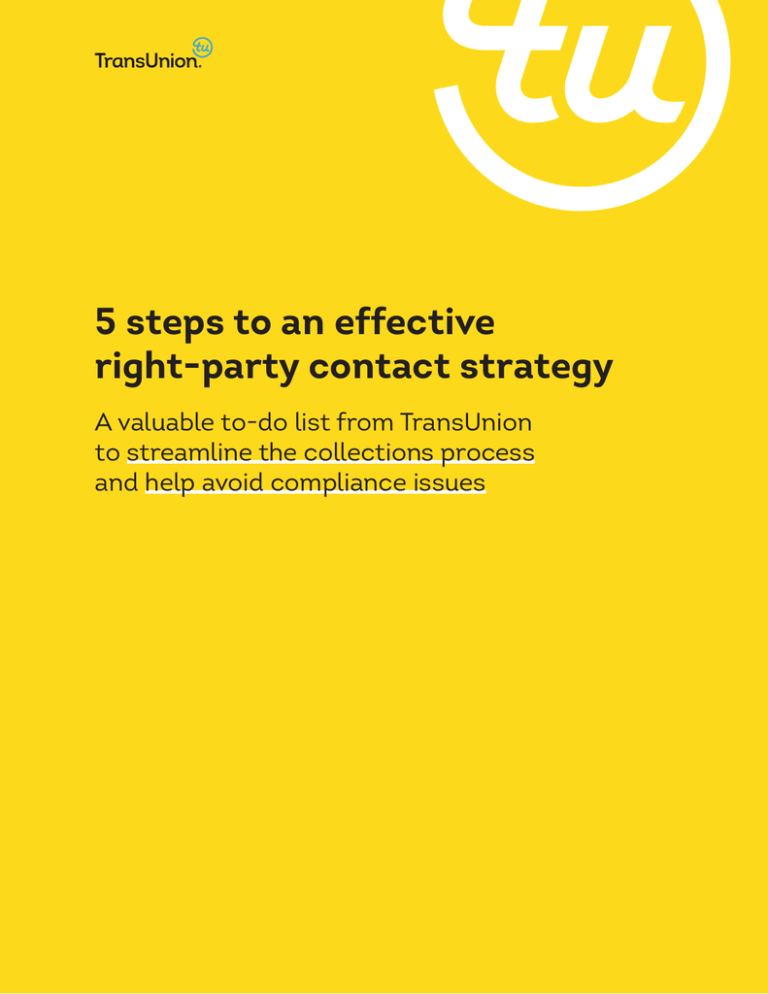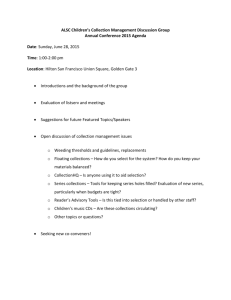
5 steps to an effective
right-party contact strategy
A valuable to-do list from TransUnion
to streamline the collections process
and help avoid compliance issues
Table of contents
5 steps to an effective right-party contact strategy
STEP 1: Examine your collections software.............................................................. 3
STEP 2: Monitor your processes................................................................................... 3
STEP 3: Handle customer disputes ............................................................................ 4
STEP 4: Stay current/ongoing education.................................................................. 4
STEP 5: Invest in accuracy............................................................................................. 4
2 | © 2015 TransUnion Risk and Alternative Data Solutions, Inc. All Rights Reserved. All trademarks referenced in this email are the property of their respective owners.
Faced with complex rules and regulations, it’s more critical than
ever to have an effective strategy for evaluating and monitoring
your right-party contact approach.
STEP 1: Examine your
collections software
→ Is it current? If your software hasn’t been reviewed
recently, you’re probably not working with the most
current updates, and that can be costly. Federal
regulations are constantly changing, and having
collections software that’s even slightly dated could
mean you’re operating under ineffectual guidelines.1
→ Is it easy to use? A user-friendly system centralizes
everything, allowing your people to review accounts,
create emails, attach invoices, log phone calls, review
disputes and more from a single page. Make sure
your system is easy to use for current and future
employees. You should spend more time on job
training than system training.1
→ Does the system fit your needs? Different
software fits different collections needs. A few
things to consider when evaluating your software
system include:
Is your business primarily B2B or B2C? Different
software packages work better for different
environments. Those geared for businesses usually
rely on automation to share information and build
relationships, while those designed for consumer
collections focus on features such as autodialers,
which aid in skip tracing.1
ROI vs TCO It’s unlikely that effective collections will
come from a minimal software investment. The key is
balancing the total cost of ownership with results.1
Take a good hard look at your software package. Does
it have tools to enhance your environment? Is it easy to
onboard staff? Does it deliver a positive ROI? If not, it
might be time to consider a more effective option..2
STEP 2: Monitor your processes
Having effective collections policies and procedures in
place is great. However, just because they’re in place
doesn’t mean they’re always followed. Conduct regular
reviews to ensure the right protocol is being followed and
that the systems you’ve put in place support right-party
requirements. A review of your compliance management
system should include questions like:
→ Does it include specific policies put in place to
ensure compliance with applicable rules?
→ Are there procedures to identify possible violations
before they escalate?
→ Have you set up a risk assessment grid for
your agency?
→ Is there a tracking plan that monitors changes to the
regulatory environment?
→ Have you capitalized on any of the affordable review
services that can guide you in a more effective
internal examination of your CRM?
→ When was the last time your externally facing
materials were reviewed and/or updated?
If you need assistance, there are affordable
resources available, including Conducting an
Internal Audit: Collection Agency Edition, available
at InsideARM.com. At a time of this checklists
publication, it cost $189 and features 35 pages filled
with best practices on defining your review, creating risk
assessment grids, understanding regulatory expectations,
tracking results and much more.
1. “2015 Accounts Receivable: Credit and Collections Software Buyer’s Guide.” Anytime Collect. June 2015.
http://blog.anytimecollect.com/accounts-receivable-software-buyers-guide-white-paper/ (accessed July 2, 2015).
2. Patterson, Lex “10 Questions to Ask Your Vendor Prior to Selecting Your Collection Software Solution: Part 1." InsideARM.com. June 2, 2015.
http://www.insidearm.com/connections-elevated/10-questions-to-ask-your-vendor-prior-to-selecting-your-collection-software-solution-part-i/ (accessed July 2, 2015).
3
|
© 2015 TransUnion Risk and Alternative Data Solutions, Inc. All Rights Reserved. All trademarks referenced in this email are the property of their respective owners.
STEP 3: Handle customer
disputes
Consumer disputes is an area that has come under
great scrutiny by regulators in recent years, particularly
the Consumer Financial Protection Bureau (CFPB),
and how you handle the disputes can have a dramatically
negative or positive effect on your business. Ask yourself
these questions:
→→ How well trained are your people in identifying
consumer disputes?
→→ Have you put together a detailed operational
handbook defining responsibilities for dispute
research and resolution?
InsideARM.com offers one of the most complete
consumer-disputes operations guides in the industry.
It’s loaded with best practices on handling disputes from
consumers, attorneys, credit reporting agencies and
others. Plus, it’s complemented by a video webinar that’s
a great tool for training staff members. A certificate of
completion is awarded that attests to your ongoing
commitment to compliance.
STEP 4: Stay current/ongoing
education
Both businesses and individuals in the industry
need to keep up to date with industry trends.
Technology is continuously advancing and regulations
are perpetually changing, so it’s vital that you keep up.
You should consider:
→→ Going to conferences
→→ Investigating new products
→→ Watching industry trends
1. The iA Institute’s Compliance Professionals Forum
2. InsideARM’s Inside Operations: A webinar series
that offers superb insight into improving collection
floor operations
3. The Debt Buyers Association's annual conference:
This conference provides an abundance of
networking opportunities with key participants in
the debt-buying industry
4. The ACA™ International Guide to State Collections
Laws and Practices: Log on to acainternational.org
for a state-by-state guide to collections laws
STEP 5: Invest in accuracy
Where is your customer information coming from? Can
you trust it to be as up to date as possible? Inaccurate
data not only wastes time and lengthens the collections
lifecycle; it may also lead to regulatory issues.
Invest in proven data sources. Free is not free! Google™
is more than likely not enough to ensure accurate and
fully compliant collections. It’s important to partner with
a database engine you can trust to deliver up-to-theminute and actionable data. If you are interested in large
quantity customer data updates to reduce manual errors,
seek a data provider that offers batch and API options.
These options are powerful, allow you to keep your data
current and help with right-party contacts.
Get the INSIGHT GUIDE
Guide to right-party contacts: How to
collect more often, faster, with an eye
toward compliance
Visit solutions.transunion/rightparty
→→ Monitoring regulations and guidelines
These days the Internet is a great teaching tool. You’ll find
all sorts of training programs and seminars related to
right-party contacts, new industry products, regulatory
changes and more. We recommend checking out the
following groups and seminars:
4 | © 2015 TransUnion Risk and Alternative Data Solutions, Inc. All Rights Reserved. All trademarks referenced in this email are the property of their respective owners.
About TransUnion solutions
for collections
TransUnion supports customers in achieving a common
goal: Collect more while spending less. Whether the
objective is prioritizing accounts, improving skip tracing
or streamlining workflow, TransUnion can help. We
combine data, analytics and in-depth understanding of
the collections industry to help organizations reduce
costs, better predict debtor behavior and increase
recovery rates. The result is that with TransUnion,
businesses can work more accounts and achieve better
results—while spending fewer resources and less time
doing so.
Questions?
For more information on TransUnion's TLOxp®, please
call 855-487-6401 or visit www.tloxp.com/collections.
For more information on TransUnion's
complete collections solution, please visit
www.transunion.com/collections.
Trademarks herein are the property of their respective owners.
Other than tloxp.com, links to or mention of websites, products or
services herein in no way implies any form of ownership of, affiliation
with or endorsement of those websites, products or services.
Websites linked herein, other than tloxp.com, are not owned or
maintained by TransUnion Risk and Alternative Data Solutions, Inc.
and no representation or warranty is made that such websites are
error-free, safe or otherwise secure.
No part of this publication may be reproduced or distributed in any
form or by any means, electronic or otherwise, now known or hereafter
developed, including, but not limited to, the Internet, without the explicit
prior written consent from TransUnion Risk and Alternative
Data Solutions.
5 | Requests for permission to reproduce or distribute any part of,
or all of, this publication should be mailed to:
Law Department
TransUnion Risk and Alternative Data Solutions, Inc.
4530 Conference Way South
Boca Raton, FL 33431
TransUnion Risk and Alternative Data Solutions is not a “consumer
reporting agency” and the products and services it provides do not
constitute “consumer reports,” as these terms are defined by the
Fair Credit Reporting Act, 15 U.S.C. Section 1681 et seq. (“FCRA”),
and further, such products and services may not be used in whole or
in part as a factor in establishing an individual’s creditworthiness or
eligibility for credit or insurance, or employment, nor for any other
purpose under the FCRA.
© 2015 TransUnion Risk and Alternative Data Solutions, Inc. All Rights Reserved. All trademarks referenced in this email are the property of their respective owners.


